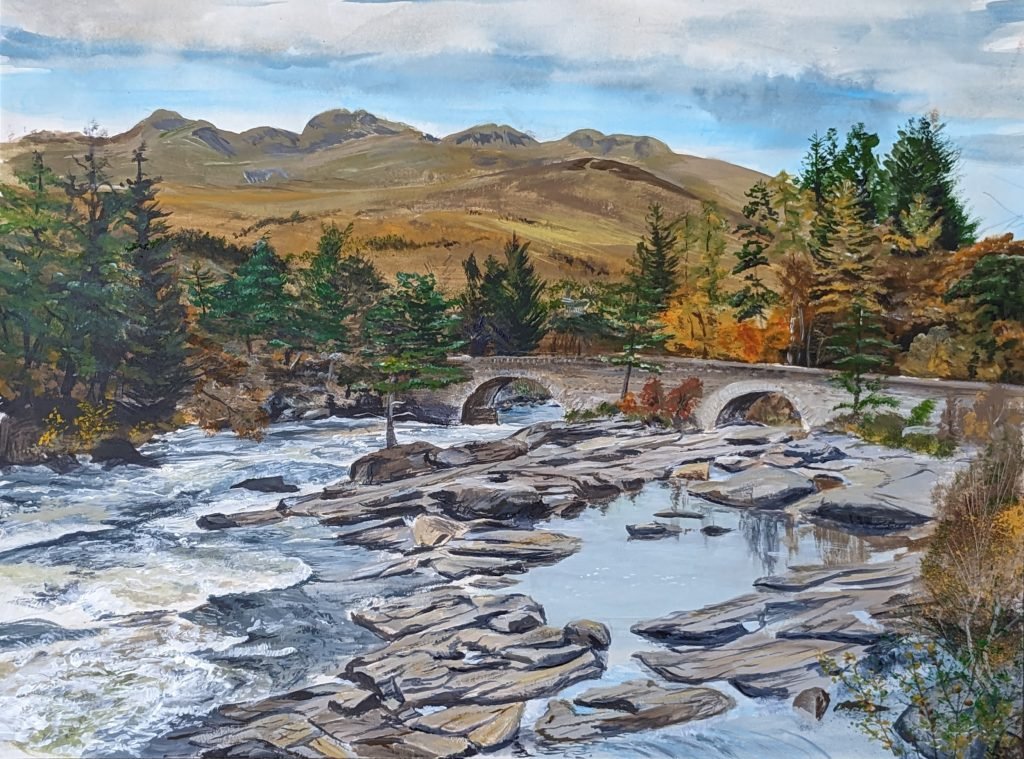A Falls of Dochart painting might include the waters in spate, or a view upstream, but whatever the angle it’s a well visited spot and easy to reach. Most visitors will have crossed into the Highlands at the gateway town of Callander, then continued onwards through Strathyre and Lochearnhead.
The road becomes the A84 there and climbs through the pass called Glen Ogle. Generations of tourism guidebook writers (including me) have parroted the description written by old Queen Victoria who travelled this way and compared Glen Ogle to prints she had seen of the Khyber Pass.
Reaching the summit of the Pass, (I mean in Glen Ogle, obviously) there are glimpses north-westwards of the impressive profiles of the big hills of Ben Lawers and its slightly less popular (but harder to spell) neighbour Meall nan Tarmachan. (It means the round hill of the ptarmigan, though I’ve never actually seen ptarmigan up there – and I’ve been on the hill a few times.)
Discovering the Falls of Dochart
If you then roll on downhill you reach Lix Toll – and if you are in a guided coach or minibus tour then your driver-guide may solemnly announce that ‘Lix’ could be the Latin for 59, recalling a Roman Legion who tramped this way. This is probably, uhmm, hokum.
I am also guessing here, but it may be from Gaelic leac, meaning flagstone or flat stone – or even gravestone. Or it could be from Norse laxa, meaning salmon (cf gravadlax) – after all, the Rover Dochart is flowing nearby (and it has plenty of flat stones too!) I don’t know, but I prefer these suppositions to a Roman legion…

To see the Falls of Dochart, you turn right (east) at Lix Toll. And a lot of people do. Visitors have come here for generations. The view of the Falls with the outliers of Meall nan Tarmachan (that big hill again) in the background is the distilled essence of Highland Scotland. (Oh, wait, isn’t that the Trossachs? No matter.)
Tributaries of the Dochart
Some of the water that roars under the old bridge here may have drained off high Ben Lui where it starts as the Allt Coire Laoigh (the Burn of the Corrie of the Calves). This in turn flows into the River Cononish that joins the River Fillan, flowing into Loch Dochart, where, reinforced by the Benmore Burn and other burns from the north, it finally becomes the River Dochart.
The water has had a lot of name changes in a comparatively short distance. More to the point, broad hill slopes and high rainfall means the Dochart is in spate regularly. The painting above shows a moderately high water – enough to flood over the rocks on the south side of the river to form a temporary pool.
Painting the Falls of Dochart, Killin
I also chose an autumn view and this is a reminder that folk visit the village of Killin to see the Falls all through the year. It’s the Highlands but certainly not remote.
As for the Falls of Dochart painting itself, it’s mostly acrylic with some acrylic gouache and some scoring and scratching. Also several cups of tea, as it was painted in the winter and it gets a bit chilly in the garden office. Still, you’re worth it. (Especially if you like the print…)
